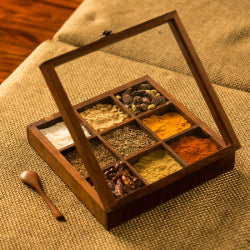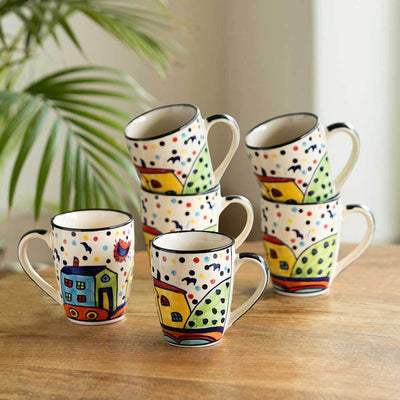Kalamkari: An Ancient Style of Hand Painting
Looking for a new and beautiful type of textile to add to your home?
Kalamkari is it!
If you already know what Kalamkari is, that’s great. But if you don’t, here is a crash course, something exciting to add to your knowledge. This crash course would, without a doubt, only make you interested in Kalamkari all the more. And if you are an art lover, then you are definitely at the right place.
Kalamkari, as you’ve already probably guessed, is a type of hand-painted cotton textile. This textile is produced in Andhra Pradesh, Iran and Isfahan. It is said to be a healing fabric because of its motif, colours and the art of storytelling behind each of the different forms of hand-painted textile of the Kalamkari.
The name ‘Kalamkari’ can be translated into ‘pen-worked’, literally (1). This ancient Style of Hand Painting has twenty-three steps, give or take, to go through to create this beautiful piece of fabric. Kalamkari is more than just a fabric, though, don’t you think? Kalamkari is an artwork with an intricate style that is hand-painted or block-printed onto textiles.
In Kalamkari only natural dyes are used which are obtained from the extracted colours from leaves, roots, and mineral salts. Some of the processes the Kalamkari undergoes to become the art it is at the end are bleaching, softening and sun drying the fabric, getting the natural dyes ready for the paintings which are later air dried and washed.
History
This ancient Style of Hand Painting, that is Kalamkari, can be dated back to as far as 3000 B.C., maybe even further back. Historians aren’t exactly sure when it began but it is an Indian Art of Organic Fabric Painting that originated, as mentioned earlier, in Andhra Pradesh and Telangana, and was used as an art of storytelling of Hindu Mythology.
The Mughals patronised this Kalamkari art in the Coromandel and Golconda provinces where the craftsmen, called Qualamkars (where the name Kalamkari originated) practised this art.
Types of Kalamkari
Srikhalahasti and Machilipatnam are the two distinctive types of Kalamkari. Srikalahasti Kalamkari, which is specifically for religious purposes, is inspired by Hindu Mythology of epic scenes and folklore, whereas Masulipatnam Kalamkari is developed for the necessity to trade with other nations. The Masulipatnam Kalamkari are printed with traditional hand blocks that have intricate details carved into them to achieve their beautiful design.
Kalamkari designs from two prime states of India, Gujarat and Andhra Pradesh, where Kalamkari are made and new designs emerged.
Design inspirations are borrowed by the Andhra Kalamkari from the temples of India, palaces and forts, along with motifs of birds and animals. While motifs of mythological characters like Lord Krishna, Lord Buddha, Lord Ganesha, Krishna-Arjuna from Mahabharata, etc are borrowed by the Gujarat Kalamkari.
The Making of Kalamkari
So much work and effort is put into achieving the desired design and paintings on a Kalamkari and can sometimes take days, maybe longer to make it. There are twenty-three steps in the process of making the Kalamkari. (2)
The Fabric used for the Kalamkari is naturally bleached first and stiffened by seeping it in buffalo milk and astringents. While this bleached fabric is left to sun dry, the natural dyes are prepared (3).
The Black dyes, Yellow, Green, Brown, Red, Pink and Blue Dyes are prepared, their shades varying for different designs they want to create. Depending on the story they’re trying to tell, they try to achieve the desired effect on the Kalamkari fabric, from the shade of green/brown of the leaves to the weather.
In the case of Srikalahasti Kalamkari, the fabric is painted and the designs/figures are outlined before the background is painted on with an alum solution. After which it is dyed, washed and dried before it is dyed red.
In Masulipatnam Kalamkari, the design is block printed and is left to dry for a few days. Water is then sprinkled on every two hours, or when it dries, this happens continuously throughout the day. It is later dipped in starch to stiffen the fabric which makes it easier to paint on. The areas that do not require dyeing are waxed and then the fabric is spread after the dyeing process. The wax is removed with hot water and the fabric is spread to air dry.
Conclusion
Kalamkari is made into different categories of fabrics from clothing to home decor. Kalamkari Sarees are widely used and they come in Cotton and other types of fabrics.
ExclusiveLane is the place to go for all your home decor as they have bright, beautiful and miniature designs, paintings and lots more to select from. ExclusiveLane Indian handicraft store has a select few Kalamkari Hand-Block Printings you should check out in their home decor category.
ExclusiveLane has other interesting and beautiful crafts with amazing history just like Kalamkari like their Pyrography art and Terracotta pottery, in different art forms like dhokra, meenakari, madhubani warli, and Indian tribal art. Their Rajasthani miniature paintings, iron handicrafts, and other crafts. ExclusiveLane has a lot of ceramic handicrafts, vases, and other crafts of India as well as brass items in different materials and art types.
Check out ExclusiveLane to beautify your home.
Read More:
Art of Enameling - The Origin Of Meenakari
All you need to know about Mughal Art Paintings






Leave a comment